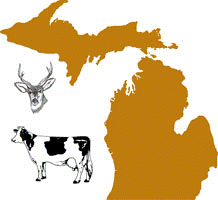Wildlife Disease and Zoonotics
Date of this Version
2003
Citation
Epidemiol. Infect. (2003) 130: 561–568
Abstract
Livestock feed is susceptible to contamination from wildlife excreta during on farm storage. Pathogens associated with diseases such as paratuberculosis, salmonella and cryptosporidiosis are present in wild rodent and bird excreta. Feed stores on four farms in the east of Scotland were monitored monthly over the winter of 1998/9 to quantify the levels of wildlife faecal contamination. A mean of 79.9 rodent (95% confidence interval: 37.5–165.9) and 24.9 (14.3–41.7) bird faeces were deposited per m2 of stored feed per month. It was estimated that individual cattle and sheep could encounter 1,626 and 814 wildlife faeces over the winter.
A model based on the numbers of infected faeces consumed per annum was used to estimate ‘infectious probabilities ’ (Pinf) required to account for the reported prevalence of paratuberculosis, salmonella and cryptosporidiosis in sheep and cattle in the east of Scotland in 1998. Based on empirical data for input variables [the number of faeces encountered (Fe), the number ingested (Fi) and the prevalence of infection in wildlife species (Ip)], Pinf estimates ranged from 1.6 x 10-8 for cryptosporidiosis in sheep to 8.2 x 10-6 for paratuberculosis in cattle. The model suggested that ingestion of feed contaminated by wildlife faeces could account for the prevalence of all three diseases. Wildlife faecal contamination of stored feed should be given serious consideration as a potential source of infection to livestock.


